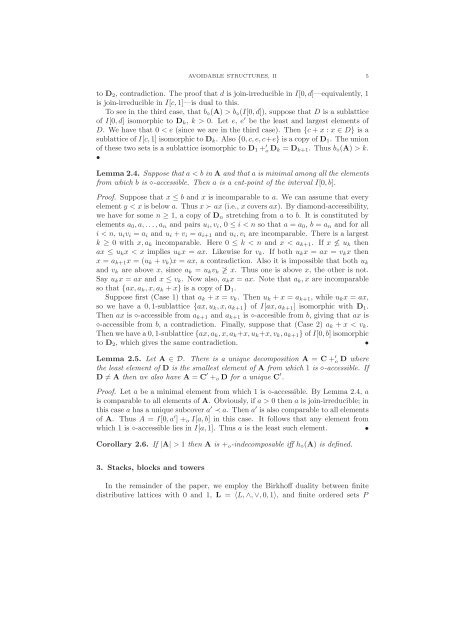Avoidable structures, II: finite distributive lattices and nicely ...
Avoidable structures, II: finite distributive lattices and nicely ...
Avoidable structures, II: finite distributive lattices and nicely ...
Create successful ePaper yourself
Turn your PDF publications into a flip-book with our unique Google optimized e-Paper software.
AVOIDABLE STRUCTURES, <strong>II</strong> 5<br />
to D 2 , contradiction. The proof that d is join-irreducible in I[0,d]—equivalently, 1<br />
is join-irreducible in I[c,1]—is dual to this.<br />
To see in the third case, that b ⋄ (A) > b ⋄ (I[0,d]), suppose that D is a sublattice<br />
of I[0,d] isomorphic to D k , k > 0. Let e, e ′ be the least <strong>and</strong> largest elements of<br />
D. We have that 0 < e (since we are in the third case). Then {c+x : x ∈ D} is a<br />
sublattice of I[c,1] isomorphic to D k . Also {0,c,e,c+e} is a copy of D 1 . The union<br />
of these two sets is a sublattice isomorphic to D 1 + ′ oD k = D k+1 . Thus b ⋄ (A) > k.<br />
•<br />
Lemma 2.4. Suppose that a < b in A <strong>and</strong> that a is minimal among all the elements<br />
from which b is ⋄-accessible. Then a is a cut-point of the interval I[0,b].<br />
Proof. Suppose that x ≤ b <strong>and</strong> x is incomparable to a. We can assume that every<br />
element y < x is below a. Thus x ≻ ax (i.e., x covers ax). By diamond-accessibility,<br />
we have for some n ≥ 1, a copy of D n stretching from a to b. It is constituted by<br />
elements a 0 ,a,...,a n <strong>and</strong> pairs u i ,v i , 0 ≤ i < n so that a = a 0 , b = a n <strong>and</strong> for all<br />
i < n, u i v i = a i <strong>and</strong> u i +v i = a i+1 <strong>and</strong> u i ,v i are incomparable. There is a largest<br />
k ≥ 0 with x,a k incomparable. Here 0 ≤ k < n <strong>and</strong> x < a k+1 . If x ≰ u k then<br />
ax ≤ u k x < x implies u k x = ax. Likewise for v k . If both u k x = ax = v k x then<br />
x = a k+1 x = (u k +v k )x = ax, a contradiction. Also it is impossible that both u k<br />
<strong>and</strong> v k are above x, since a k = u k v k ≱ x. Thus one is above x, the other is not.<br />
Say u k x = ax <strong>and</strong> x ≤ v k . Now also, a k x = ax. Note that a k ,x are incomparable<br />
so that {ax,a k ,x,a k +x} is a copy of D 1 .<br />
Suppose first (Case 1) that a k +x = v k . Then u k +x = a k+1 , while u k x = ax,<br />
so we have a 0,1-sublattice {ax,u k ,x,a k+1 } of I[ax,a k+1 ] isomorphic with D 1 .<br />
Then ax is ⋄-accessible from a k+1 <strong>and</strong> a k+1 is ⋄-accesible from b, giving that ax is<br />
⋄-accessible from b, a contradiction. Finally, suppose that (Case 2) a k + x < v k .<br />
Thenwehavea0,1-sublattice{ax,a k ,x,a k +x,u k +x,v k ,a k+1 }ofI[0,b]isomorphic<br />
to D 2 , which gives the same contradiction.<br />
•<br />
Lemma 2.5. Let A ∈ D. There is a unique decomposition A = C + ′ o D where<br />
the least element of D is the smallest element of A from which 1 is ⋄-accessible. If<br />
D ≠ A then we also have A = C ′ + o D for a unique C ′ .<br />
Proof. Let a be a minimal element from which 1 is ⋄-accessible. By Lemma 2.4, a<br />
is comparable to all elements of A. Obviously, if a > 0 then a is join-irreducible; in<br />
this case a has a unique subcover a ′ ≺ a. Then a ′ is also comparable to all elements<br />
of A. Thus A = I[0,a ′ ] + o I[a,b] in this case. It follows that any element from<br />
which 1 is ⋄-accessible lies in I[a,1]. Thus a is the least such element. •<br />
Corollary 2.6. If |A| > 1 then A is + o -indecomposable iff h ⋄ (A) is defined.<br />
3. Stacks, blocks <strong>and</strong> towers<br />
In the remainder of the paper, we employ the Birkhoff duality between <strong>finite</strong><br />
<strong>distributive</strong> <strong>lattices</strong> with 0 <strong>and</strong> 1, L = 〈L,∧,∨,0,1〉, <strong>and</strong> <strong>finite</strong> ordered sets P
















